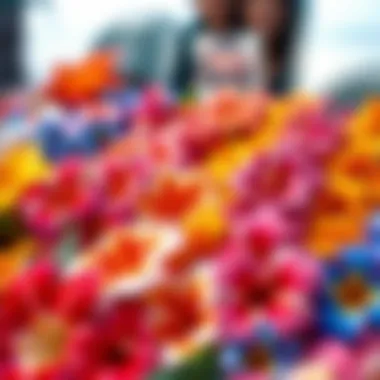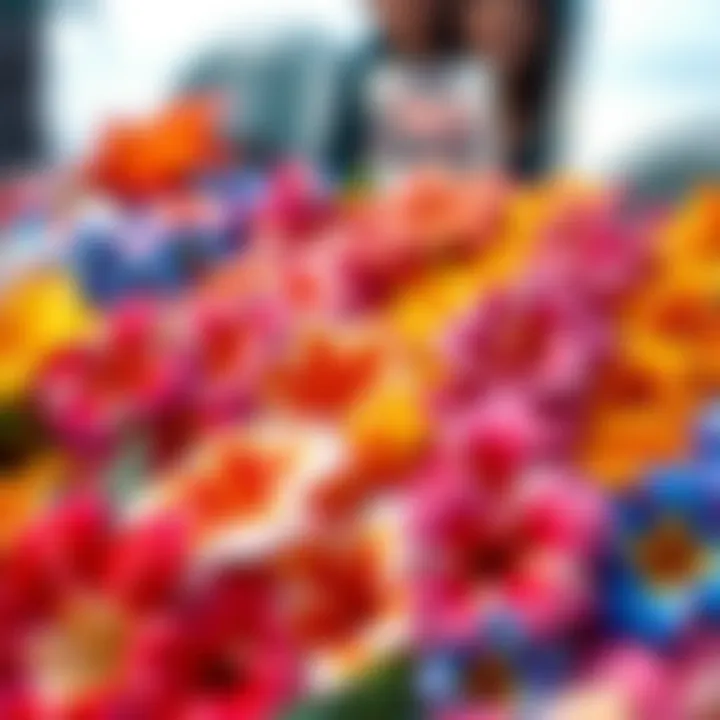The Significance and Craft of Hawaiian Lei Flowers


Intro
When we think of Hawaii, the vivid images of sun-soaked beaches, vibrant sunsets, and lush landscapes come to mind. But woven into this picturesque scene is a profound cultural symbol—the Hawaiian lei. These garlands, made from a variety of local flowers, hold much more than mere aesthetic appeal. They are a bridge between the past and present, representing love, respect, and the bonds of friendship.
Hawaiian lei flowers go beyond being decorative; they embody the spirit of the islands and reflect the environmental richness of the region. From their usage in ceremonial rites to their role in modern celebrations, leis weave a narrative that connects the core of Hawaiian identity with the natural world around it.
As we navigate through this exploration, we'll delve into the artistry involved in crafting leis, the seasonal blooms that dictate their availability, and the intimate relationship between these beautiful creations and surfing culture. This journey is not just about leis, but also about understanding the broader ecological implications tied to their cultivation, enabling us to appreciate this custom on a deeper level.
With that said, let us embark on discovering not just the significance of Hawaiian lei flowers, but also practical insights that can enhance your connection to Hawaii's culture and its magnificent ocean waves.
Understanding Hawaiian Lei Flowers
Hawaiian lei flowers are not just colorful adornments; they represent an intricate part of Hawaiian culture, infused with history, symbolism, and artistic craftsmanship. Everything about them speaks of relationships, from the bonds created through their gifting to the appreciation of the exquisite flora they originate from. Understanding the essence of these flowers goes beyond just knowing their vibrant colors and fragrant scents. It involves delving into the historical context, the cultural importance, and the underlying meanings that they carry. This article aims to peel back the layers and shed light on how these unique floral creations resonate within the very fabric of Hawaiian society.
Historical Context
The roots of the Hawaiian lei extend deep into the annals of time. Historically, these garlands were worn as a sign of affection and respect. Crafted from native plants, the lei were initially used in religious ceremonies and significant cultural events. Early Polynesians brought their knowledge of lei-making to Hawaii, using sweet-smelling flowers like the wili wili, or the delicate, intertwining vines of the maile. As centuries passed, the use of lei evolved. During the unification of the Hawaiian Islands, rulers donned elaborate lei to signify their status and connection to land and people. To understand the historical significance of lei flowers assists in appreciating their role in present-day practices.
Cultural Significance
In modern Hawaiian culture, lei flowers symbolize much more than mere decoration. They encapsulate expressions of love, welcome, and farewell. At graduations, weddings, or even during just casual meet-ups, a lei can mark a moment of celebration or remembrance. The act of gifting a lei comes with a sense of gratitude and mutual respect, creating a moment of connection between the giver and the receiver. Furthermore, lei-making has evolved into a celebrated art, with many local communities hosting workshops and events aimed at passing down these skills to future generations. This practice ensures that not only are the flowers preserved in their natural beauty, but the stories and traditions tied to them are kept alive as well.
Symbolism in Hawaiian Culture
Within the layers of petals lies a rich tapestry of symbolism, deeply embedded in Hawaiian culture. Each flower used in a lei carries its own significance. For instance, the vibrant plumeria is often associated with positivity and new beginnings, while the sweet-smelling tuberose signifies purity and innocence. The act of wearing a lei can also convey messages and feelings, such as respect, affection, or grief. Moreover, lei flowers reflect the interconnectedness of life, linking people to nature and their communities. This connection resonates well with the island's surfing culture, where both the ocean and the land intertwine to create a harmonious balance between nature and everyday living. Thus, appreciating Hawaiian lei flowers fosters a deeper understanding of both their aesthetic appeal and their profound cultural resonance.
Types of Hawaiian Lei
Understanding the diversity of Hawaiian lei is crucial to appreciating their cultural richness and artistic expression. Hawaiian leis come in various forms, each with its own significance and crafting techniques. This section will delve into the distinct types of lei—floral, shell, and green—each offering unique characteristics and benefits.
Floral Lei
Commonly Used Flowers
The floral lei is perhaps the most recognized type, crafted primarily from blossoms. Some of the commonly used flowers in creating these leis are plumeria, hibiscus, and orchids.
- Plumeria: Known as frangipani, plumeria holds a special place in Hawaiian culture. It is often associated with love and beauty, making it a popular choice for leis presented during weddings or special occasions. Its fragrance is another factor that draws artisans to this flower, as it emits a captivating scent.
- Orchids: These blooms are celebrated for their variety and color, allowing for stunning designs. They are resilient flowers, which means they can maintain their beauty for a longer duration.
- Hibiscus: Although not used as frequently for leis as plumeria and orchids, hibiscus adds a stunning visual element to any lei. Its large, vibrant petals make for eye-catching adornments.
While these flowers offer considerable aesthetic appeal, it’s essential to consider their seasonality. Knowing when to gather these blooms ensures that they’re harvested at their prime, yielding the freshest and most fragrant leis.
Techniques for Crafting
Crafting a floral lei requires a blend of patience and skill. The primary technique involves stringing the flowers together with threads, twine, or sometimes even fishing line. The design principles often focus on balance in color and size,
- Tying Techniques: There are various tying methods, including the double knot and the needle technique, each providing different textures and looks to the final product. Mastery of these techniques allows artisans to create elaborate and diverse styles, making floral leis a unique expression of creativity.
- Design Principles: Color coordination plays a significant role in crafting floral leis. Artists often use contrasting or complementary colors to enhance the visual appeal. A well-crafted lei can represent various themes or evoke certain emotions through flower selection and arrangement.
Shell Lei
Materials Used
Shell leis are a testament to Hawaii’s connection with the ocean, incorporating natural materials that speak to the environment. Commonly used shells include puka shells and cowrie shells.
- Puka Shells: These are naturally occurring shells with a hole in the middle, mostly found on Hawaiian beaches. Their distinct look brings a beachy, casual essence to the lei, making them a popular choice for informal or laid-back gatherings.
- Cowrie Shells: Historically regarded as currency in some cultures, cowrie shells symbolize wealth and prosperity. Their shiny surface adds a touch of elegance to any lei.


The unique feature of using shells is their durability. Unlike floral leis, which may wilt, shell leis can be preserved for years, making them cherished mementos from Hawaiian experiences.
Cultural Context
The cultural context of shell leis extends beyond decorative purposes. Historically, they were worn during special ceremonies and events, signifying social standing or the wearer’s connection to the sea.
- Symbolic Connection: Wearing a shell lei often denotes a close connection to the ocean, emphasizing respect for the land and sea, which is a vital theme in Hawaiian culture.
- Craftsmanship: The artistry involved in crafting shell leis requires meticulous attention to detail as each shell must be carefully selected and arranged to ensure a cohesive and visually pleasant outcome.
Green Lei
Plant Materials
Green leis, often crafted from leaves and other greens such as ti leaves or maile, are embodiment of the lush Hawaiian flora. Utilizing plant materials reflects a more earthy aspect of lei-making.
- Ti Leaves: These wide leaves are common for traditional leis, known for their longevity and rich green color.
- Maile: Traditionally, maile is associated with peace and is often used in special ceremonies like weddings or graduations. The sweet fragrance imparted by maile adds a sentimental touch to the lei.
The advantage of using plant materials is their availability and sustainable nature, as they can often be harvested without harming the environment.
Symbolic Meanings
The meanings behind green leis can be complex and multifaceted. They often symbolize prosperity, peace, and the deep-rooted connection to nature and heritage.
- Cultural Significance: Leis made from greens are often used in ceremonial contexts, representing blessings and good fortune.
- Nurturing Community Ties: These leis can also signify unity within the community and an appreciation for the land. Using plant materials in crafting not only elevates the significance of the lei but also brings awareness to the elements that sustain the unique Hawaiian environment.
"In Hawaiian culture, a lei is a representation of aloha, encompassing the spirit of kindness, love, and connection to nature."
By exploring the various types of Hawaiian lei and their intricate components, we gain a more profound appreciation for their cultural significance and craftsmanship. The beauty of these leis lies not only in their physical attributes but also in the rich meanings they carry. Through the art of lei-making, Hawaiians express their connection to the land, the ocean, and each other, weaving a tapestry of tradition that continues to thrive to this day.
Crafting Techniques
The art of crafting Hawaiian lei is not just a simple pastime; it is a cherished tradition steeped in heritage, artistry, and personal expression. The process of making lei is a reflection of the history and culture of Hawaii, encapsulating the beauty of the islands and the great respect the people have for nature. Crafting techniques bridge the gap between creativity and practicality, allowing individuals to create something personal yet instantly recognizable as Hawaiian.
Gathering Materials
Gathering the right materials is a critical first step in the crafting process, which sets the foundation for a stunning lei. In order to create an authentic Hawaiian lei, one must not only consider aesthetic qualities but also the ecological aspects of sourcing.
Flowers, leaves, and shells should be collected with respect for the environment, ensuring that selections come from abundant sources and are not vulnerable to overharvesting. Local gardens, wildflower areas, and community sources provide a treasure trove of options for crafters. Some of the most commonly used materials include:
- Plumeria, known for their soft petals and fragrant aroma
- Ti leaves, which provide a lush green backdrop
- Ohia lehua, celebrated for its bright red blooms
Personal connections to the gathering site can imbue the lei with even more meaning, making this part of the crafting process as rewarding as the final product itself.
Traditional Methods
The traditional methods of crafting lei have been passed down through generations, embodying a way of life that values patience, attention to detail, and connection to the land.
Tying Techniques
Tying techniques are integral to the structure and durability of the lei. Different styles, like the commonly used double-knot or the more intricate sashimi style, can impact the overall look and flair of the lei. The double-knot technique, for example, is often appreciated for its simplicity and effectiveness. It ensures that each flower is securely held in place, while also allowing a natural flow of movement.
The beauty of these techniques lies in their versatility. Depending on the desired aesthetic, crafters can choose a more linear approach or a more whimsical design. One challenge with tying techniques, however, is ensuring that the adjustments during crafting do not lead to uneven spacing among flowers, which can affect the visual appeal and balance of the lei. Practicing these methods can lead to greater skill and appreciation in the art.
Design Principles
Design principles in lei-making play a pivotal role in determining the aesthetic value of the finished product. Factors such as color harmony, shape variation, and flower size aren't just technical concerns; they are integral to creating a lei that resonates culturally and personally. Crafters might opt for a monochromatic theme to evoke elegance or a vibrant mix for a festive feel.


Just like in any form of art, effective design principles can elevate a simple lei into a breathtaking piece of wearable art. However, too much emphasis on complex designs can sometimes lead to a cluttered appearance, which undermines the natural beauty of the materials used. Thus, striking a balance between complexity and simplicity is critical for successful lei-making.
Modern Innovations
With surf culture and the evolving landscape of Hawaiian traditions, modern innovations in lei crafting are emerging. New materials, such as synthetic flowers or beads, are beginning to coexist with the traditional components, leading to hybrid styles. Techniques from other crafting disciplines, like macramé, are also making their way into the lei world. By combining these innovative ideas with time-honored traditions, crafters can create distinctive pieces that pay homage to their roots while pushing the envelope on creativity.
Seasonal Blooms and Sourcing
Understanding the best times to gather flowers and finding local sources for them plays a crucial role in creating beautiful and meaningful Hawaiian leis. This section unfolds the significance of seasonal blooms and sourcing, exploring how they not only enhance the lei-making process but also carry implications for sustainability in Hawaiian culture.
Best Times to Gather Flowers
The cyclical nature of flora in Hawaii means that each season offers its own unique blooms, ideal for lei crafting. Knowing when to gather flowers can elevate the essence of a lei, making it more vibrant and fragrant. Here are a few key points regarding the best times to gather:
- Spring: This season usually brings a burst of color, particularly with the blossoms of the plumeria, which can be found blooming from March to May. These fragrant flowers are a staple in many floral leis.
- Summer: This is often peak lei season, with a variety of flowers such as hibiscus and bougainvillea in full bloom. Gathering during this time can ensure a rich selection, perfect for celebrations such as graduations and weddings.
- Fall and Winter: While these seasons may not boast as many options as summer, they do bring unique flowers like the yellow ilima or the native aiea. Preparing leis during these months can often have a more personal touch, as the flowers can symbolize different life events.
"Every flower tells a story, and in the lei crafting world, timing is everything."
By aligning flower gathering with their blooming cycles, makers can create leis that are both fresh and meaningful. Understanding seasonal patterns leads to better quality floral arrangements and a deeper connection to nature's rhythms.
Local Sources and Sustainability
Sourcing flowers for lei making often extends beyond just knowing the seasons. Ethical gathering and sustainable practices are paramount as they preserve the natural ecosystems that provide these beautiful blooms.
- Community Gardens and Local Growers: Engaging with local nurseries and gardens can help enthusiasts find sustainably grown flowers. Many communities maintain gardens specifically for lei flowers, allowing for ethical harvesting.
- Wildflower Conservation: As tempting as it might be to pick wildflowers, it’s essential to practice conservation. Always check if flowers are part of a protected species or ecosystem and gather responsibly to prevent harming native habitats.
- Education and Workshops: Participants can immerse themselves in the local culture and sustainable practices by attending workshops that educate on the significance of each flower and its respective harvesting practices. This not only keeps skills alive but also fosters a sense of community.
Incorporating sustainability into the sourcing process not only benefits the environment but also enriches the crafting of leis. When you choose to respect nature, the final product carries not only beauty but also meaning and responsibility.
For more insights into local Hawaiian flora, you may visit Hawaiian Ecosystems and Flora or Native Hawaiian Plants.
By taking into account seasonal availability and ethical sourcing, admirers of Hawaiian leis can create masterpieces that honor both tradition and the natural world.
Environmental Considerations
The significance of environmental considerations in the crafting and use of Hawaiian lei flowers cannot be overstated. As the popularity of these beautiful floral adornments grows, it's vital to acknowledge their implications on Hawaii's rich ecosystem. This section delves into the impact of lei production and the efforts to preserve native flora, examining how these factors intertwine with cultural traditions and the pressing need for sustainability.
Impact of Lei Production
Lei production often occurs in harmony with natural cycles, showcasing the relationship between the land and its people. However, this practice can sometimes take a toll on native plants if not managed correctly. The demand for certain flowers can lead to overharvesting, threatening the delicate balance of Hawaii’s native ecosystems. Coral, for instance, is intertwined with certain types of shell lei, leading to conversations about responsible sourcing that protects marine life.
Part of the solution lies in sustainable practices. By steering efforts towards locally sourced materials and advocating for replanting, the community can help mitigate the negative impacts of lei production. Simply put, planting more of what’s used can help ensure that future generations can enjoy these beautiful creations without compromising the biodiversity of the islands.
Preserving Native Flora
Conservation Efforts
One remarkable aspect of conservation efforts in Hawaii is the focus on restoring native plant species that have faced challenges due to invasive species and climate change. These initiatives not only help in preserving the cultural significance of lei flowers but also contribute to the overall health of the island's ecosystems. For example, organizations like the National Tropical Botanical Garden lead projects that reintroduce native plants back into their natural habitats. This approach stands out as a beneficial choice because it revives traditional practices and emphasizes the use of indigenous materials for crafting lei, bringing a fresh perspective on sustainability.
The unique feature of these conservation efforts is the collaboration with local communities. Residents become stewards of the land, fostering a sense of pride and ownership over their natural resources. However, it’s necessary to note that these efforts can face challenges, including funding limitations and the ongoing threat from invasive species. Still, the positive outlook from these projects highlights the potential for creating a strong foundation for sustainable lei crafting practices.
Community Initiatives
Community initiatives play a crucial role in preserving lei culture while also fostering environmental stewardship. Groups of local enthusiasts often come together to educate each other about the importance of using native plants and the sustainable methods of crafting. These gatherings serve not only as knowledge-sharing hubs; they also strengthen ties within neighborhoods and establish a collective commitment to protect Hawaii's unique flora.


The emphasis on communal engagement makes these initiatives a popular choice for many. Not only do they allow for the preservation of traditional crafting techniques, but they also lead to a greater understanding of ecological systems among the participants. There can be challenges, such as varying levels of commitment within groups or differing opinions on best practices. Nevertheless, the core value of these community efforts lies in the shared recognition of the delicate balance between culture and environment.
Preserving native flora through community efforts and updates in conservation practices ensures a brighter future for Hawaiian lei flowers, both culturally and ecologically.
Lei Flowers in Contemporary Context
In today’s fast-paced world, the tradition of Hawaiian lei flowers has transitioned into a modern context while still anchoring its roots in cultural significance. They are no longer just simple accessories; they have morphed into symbols of warmth, welcome, and celebration across various aspects of life. The importance of understanding this evolution cannot be overstated, particularly for those engaged with Hawaiian culture, such as surfers, travelers, and outdoor enthusiasts.
Modern Uses
lei flowers find themselves embraced in many contemporary rituals and experiences. You’ll often spot them around the necks of visitors upon their arrival at Hawaiian airports, a gesture that signifies a warm embrace of the islands’ culture right from the start. Their use is not limited to arrivals; they also grace weddings, graduations, and other significant life events. Here are a few examples:
- Weddings: Couples often opt for floral lei as part of their nuptial garb, weaving the natural beauty into their vows. The lei serves not only as decoration but also carries deep personal meanings to the bride and groom.
- Corporate Events: Many businesses utilize lei flowers in their events to create an atmosphere of cooperation and goodwill. It’s a way to showcase respect and appreciation for one another, integral values in Hawaiian culture.
- Cultural Festivals: Events like the Aloha Festivals showcase the diversity of lei flowers, promoting local culture and craft, all while attracting countless visitors eager to bask in the spirit of Aloha.
This contemporary significance of lei flowers goes beyond appearance; they represent connection, community, and continuity.
Tourism and Lei Culture
Tourism has played a pivotal role in the transformation of lei culture. For many travelers, wearing a lei is a rite of passage, a part of the quintessential Hawaiian experience. It’s fascinating to note that, historically, the lei was a reflection of the environment, crafted from local flora. Now, while traditional floral varieties continue to shine, the options have expanded. Tourists often seek unique variations that incorporate elements like shells or even synthetic materials, which still aim to capture the spirit of Hawaiian craftsmanship.
"Lei culture enhances the visitor experience, creating an emotional connection to the islands and its people."
It’s paramount to approach tourism responsibly. With the influx of visitors, there arises a pressing need for sustainable practices in the harvesting of flowers. This includes respecting local ecosystems and supporting farmers who adhere to ethical, environmentally-friendly methods.
The intertwining of tourism and lei culture evokes conversations about identity and commercialization. While there’s no denying the economic benefit, the challenge lies in maintaining authenticity amidst mass consumption.
Integrating Lei Culture with Surfing
When you think of surfing, images of sun-kissed waves and sandy shores likely fill your mind. Yet, there is a deeper layer intertwined with this exhilarating activity, particularly in Hawaii, where the practice of surfing is steeped in rich cultural significance. Integrating lei culture with surfing serves to enhance not only the enjoyment of the waves but also the understanding of Hawaiian traditions. This fusion offers ways for surfers to connect with the place they are riding those perfect swells while appreciating the cultural heritage that surrounds it.
Connecting with Native Practices
The legacy of surfing in Hawaii goes beyond just catching waves; it's rooted in native practices that celebrate the ocean as sacred. Traditionally, Hawaiian surfers, or "heʻe nalu," would adorn themselves with lei before entering the water. This act was more than just aesthetics—it was a ritual performed to honor the ocean and the spirits within it. It created a symbolic connection between the surfer and the natural environment, incorporating elements of respect and mindfulness.
Moreover, using lei in these practices fosters a cultural bond not only among the surfers but also with the community. Each flower and material in a lei has its own story and meaning, echoing the cultural narratives that Hawaiian ancestors passed down through generations. By showcasing these leis, surfers can embody the spirit of unity and connection that permeates Hawaiian culture, ensuring that respect for the land and water remains integral to the sport.
Community Events and Surfing
Community events in Hawaii often weave together surfing and lei crafting, creating opportunities for locals and visitors alike to engage with one another in a meaningful way. These events, from surfing competitions to traditional festivals, highlight the cultural significance of lei while showcasing the beauty of Hawaiian waters.
Participating in such gatherings fosters a sense of camaraderie that transcends simple surf sessions. It allows surfers to learn from the wisdom of elders, to deepen their understanding of traditional practices, and to share in the collective pride of their heritage. For instance, humble beach clean-ups are often accompanied by gatherings featuring lei-making workshops. Here, surfers get the chance to learn how to create their own floral adornments while discussing the importance of sustainable practices—keeping in mind that the flowers they use are tied to the very land they surf upon.
"The lei is not just a symbol of beauty; it is a reminder of our connection to nature and each other."
Through these events, communities can build a bridge between the modern-day surfer's lifestyle and the cultural significance of the lei, ensuring that the legacy of Hawaiian traditions remains vibrant. As communities gather to surf, celebrate, and create, they reinforce the importance of recognizing and respecting the cultural tapestry that defines Hawaii. \n Ultimately, integrating lei culture with surfing leads to a more profound appreciation of Hawaiian traditions, encouraging surfers to ride the waves with a renewed sense of purpose and responsibility. This connection enriches their experience and preserves the spirit of Aloha for generations to come.
Ending
The importance of concluding this exploration of Hawaiian lei flowers lies in encapsulating the profound essence of these garlands within Polynesian culture. A lei is not merely a string of blossoms; it’s a rich tapestry of history, identity, and artistry intertwined with the land. In today’s world, understanding the enduring legacy of lei goes beyond aesthetics. It’s a bridge connecting modern practices with traditional values.
The Enduring Legacy of Hawaiian Lei Flowers
Lei flowers container a myriad of meanings and memories that echo tales from long ago. Historically, these symbolic adornments were not just worn for beauty. They signified hospitality, love, and remembrance. When offered, a lei exemplifies respect and acknowledgment, reflecting the spirit of aloha. In contemporary Hawaii, this legacy remains vital. The simple act of gifting or wearing a lei serves as a reminder of one’s roots and the natural elegance of the islands.
Through age-old techniques, such as the art of plaiting and knotting, Hawaiian lei crafting encapsulates both artistry and skill. Many skills have been passed through generations, breathing life and continuity into the culture. Practicing this craft offers a buffer against the erosion of these timeless traditions, showing that the ability to create something beautiful with one’s hands can be grounding in a rapidly changing world.
By integrating the practice of crafting lei with festivals, surf competitions, and community events, people are not only celebrating their love for the ocean but are also keeping the traits of their ancestors alive. This connection with surfing culture in Hawaii offers a fresh perspective on how lei flowers symbolize a continuity of legacy and identity.
"A lei is more than a flower; it is a connection to the land and to each other."
Thus, the enduring legacy of Hawaiian lei flowers speaks volumes about respect towards nature, appreciation of craftsmanship, and the strength of community. Understanding their true significance ensures that this beautiful tradition remains unbroken for future generations, fostering a sense of identity and belonging that resonates with both locals and visitors alike. The benefits of cultivating this awareness are manifold, creating a richer experience for surfers, travelers, and outdoor enthusiasts who seek to embrace the natural beauty and cultural richness of Hawaii.



